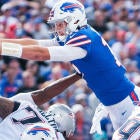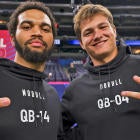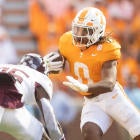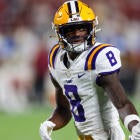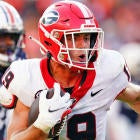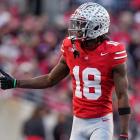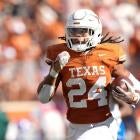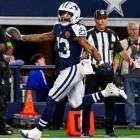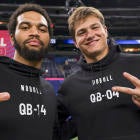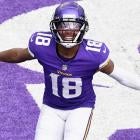With the 2019 regular season in the books, I'll be going division by division to share my initial offseason takeaways from each team.
This is mostly postseason note-taking as I emphasize what stands out most from the Stealing Signals column in 2019. We have an entire offseason of coaching and personnel changes plus additional research to break down what our 2020 Fantasy expectations will be, but I intend to refer back to these pieces as a barometer of sorts.
Buffalo Bills
Snap Notes: Devin Singletary — 68% in Week 1, 33% in Week 2 (injured), 38% in Week 7 (return), 66% or higher from Week 8 on, expanding to as high as 96% in Week 16
Key Stat: Josh Allen — 9 rush TD (8 in 2018)
One of the things we see with rushing quarterbacks is the production they accumulate on the ground limits the production of the skill position players on the offense. The backs aren't touching the ball on those plays; no one is catching a pass.
That was less of a concern for an offense as potent as Baltimore's, but it was a different story in Buffalo. The Bills finished 23rd in points scored and 24th in yards from scrimmage, so they weren't exactly a bottom-tier offense, but because Josh Allen's nine rushing touchdowns accounted or more than a quarter of their 34 offensive touchdowns. In large part because of that, their skill position players combined for the 29th most PPR points in the league.
This will likely be the way things go throughout Allen's career. He took steps forward as a passer, but after not throwing for more than 250 yards in a game in his rookie season — despite a big arm and the ability to create splash plays down the field — he topped out at 266 passing yards in Year 2. That's both due to the ball-control-and-defense mentality of the offense and also his issues being consistently accurate, and he missed several big plays throughout the season.
At least that limited receiving volume was heavily concentrated, with John Brown being the clear No. 1 most of the season, and Cole Beasley coming on late as the only other key contributor in the passing game. Brown finished seventh in the NFL in air yards, and his efficiency was solid but had the potential to be great had Allen not missed him on multiple deep throws throughout the season. He'll likely be a 2020 draft value relative to his WR22 PPR finish, but I'd argue there's good reason for that as his upside may be hard to reach.
Beasley posted career highs in targets (105), aDOT (8.1) and touchdowns (six), finishing WR34 after a strong late-season run. He turns 31 in April and even at a likely late-round ADP, isn't exactly a 2020 target even in PPR leagues, especially because it seems likely Buffalo will add to the position in the offseason.
Rookie third-round pick Dawson Knox was third on the team in targets with 50, and he has some long-term potential but will likely deal with a target ceiling. It's always possible Allen takes another step forward with his accuracy, but his playing style will likely continue to limit overall targets so it's a tough needle to thread for the third or fourth weapon in this passing game to have much Fantasy value.
Devin Singletary will be a hot breakout name after he put up 5.1 yards per carry. His early injury limited his overall games played and also snaps in Weeks 2 and 7 (the game where he was injured and his return), and his 29 receptions in the other 10 games speak to plenty of potential in the passing game. With Frank Gore likely gone, and Singletary's role expanding as the season went along, it's a fair bet the youngster will be something close to a workhorse in 2020. The biggest problem with be touchdown production, as he rushed for just two scores all season, something that can be directly tied to Allen racking up 11 rush attempts inside the 10-yard line in 2019. Singletary had just four.
That said, both of Allen's seasonal rushing touchdown totals thus far in his career (nine in 2019, eight in 2018) are top-10 quarterback totals since the merger. Cam Newton similarly started his career with two strong rushing touchdown seasons (14 in his rookie year, eight in Year 2), but has had more than six in a season just once more. It's probably fair to expect Allen to regress a bit there, even as it's clear that's a featured part of the goal-line offense, and if Allen only has something like six rushing scores in 2020 it should mean a few more short scores for Singletary.
Signal: Devin Singletary — limited touchdown ceiling with Allen's rushing touchdown presence; John Brown — strong downfield role, probably a limited ceiling on the efficiency
Noise: Josh Allen — probably won't rush for 8+ touchdowns every season
Miami Dolphins
Snap Notes: Mike Gesicki — 56% average snap share through Week 10, 76% from Week 11-17; Preston Williams — became a full-time player in Week 3 through his Week 9 injury
Key Stat: DeVante Parker — 1,783 air yards (third most in NFL)
Miami's season can be broken into parts, with guys like Josh Rosen and Kenyan Drake becoming afterthoughts compared to the relative late-season success they found. The way I see it, it's not really worth diving into the early parts of the season much, as Miami figures to overhaul their roster all offseason.
But what we learned late is that DeVante Parker could very well be finally making good on his considerable promise, Preston Williams has plenty of potential after going undrafted in the 2019 draft and Mike Gesicki has potential to be a useful tight end.
We also learned Ryan Fitzpatrick remains a great figure in Fantasy Football both because he can put up usable Fantasy lines as a quarterback and because his willingness to throw the ball down the field and play a high-variance style of quarterback that opens up plenty of Fantasy scoring for his pass-catchers. But that latter point might mean the sum of the production for Parker, Williams and Gesicki will be hard to match if the 2020 quarterback plays a different style.
Parker played the first 16-game season of his career, and his 1,783 air yards were third-most in the league. His 9.4 yards per target and 7.0% touchdown rate were both strong efficiency numbers, but probably need to be met with some skepticism given his prior career rates of 7.9 and 3.2% on a 280-target sample. Still, he'll turn 27 in January, is right in his prime and likely won't cost anywhere near his WR11 PPR finish in 2020 drafts. He'll be a risk-reward proposition in drafts.
Part of the risk will be Parker's health, while another part will be whether he can maintain that type of volume if Preston Williams is healthy. Per the RotoViz Game Splits App, Parker averaged 9.5 targets per game in the eight games Williams missed versus 6.5 in the eight Williams played, and airyards.com tells us 57% of Parker's air yards came in the back half of the season (which Williams missed). Parker's receiving yardage per game more than doubled in that stretch, and while some of that can be chalked up to Rosen playing extensively in the Williams sample, that also speaks to the impact Fitzpatrick had on the offense, which might not be there in 2020.
As for Williams, all indications are great. He was nearly deadlocked with Parker in PPR scoring in the games both played, and while his 7.3 YPT makes him look like the far less efficient player than Parker overall, it wasn't far off from Parker's 7.7 YPT to that point in the season. It's important to remember the quarterback play changed substantially down the stretch, and while the Parker and Fitzpatrick second-half connection (11.1 YPT) was symbiotic and shouldn't be solely chalked up to better quarterback play, it also wouldn't be right to compare Parker's and Williams' full-season numbers directly. My rough guess for 2020 is the duo will be something like co-No. 1s, but Parker's late-season production should give him the edge in drafts.
Gesicki was the other notable name in the passing game, and he finished PPR TE12 on the season, but was also far more productive in the back half of the season. The athletic second-year pro's snaps rose considerably in the second half, and his 10.1 aDOT for the season was fifth-highest among all tight ends with at least 50 targets. Projecting out his 2020 role is tough at this stage, but there's certainly some upside here.
Drake's time in Miami is far less important than what he did in Arizona, and the rest of the Dolphins backfield — Kalen Ballage, Mark Walton, Patrick Laird, Myles Gaskin — don't figure to be long-term answers.
Signal: Preston Williams — strong rookie season production; DeVante Parker — took a big step forward in both health and production; Mike Gesicki — potential Year 3 breakout tight end
Noise: DeVante Parker — half-season splits are noisy, but we have to recognize Parker benefited from a multitude of factors to propel his second half; Team — overall passing production in second half of season if Fitzpatrick isn't back
New England Patriots
Snap Notes: N'Keal Harry — made five starts, but broke 60% in just one regular season game
Key Stat: Team — 10 players saw 20+ targets (including just one TE)
What to make of New England? Tom Brady isn't expected to retire, but it's not clear if he'll be back with the Patriots. Bill Belichick likely isn't going anywhere, and as long as he's in charge I'm of the mind the team will be successful. This man once won 11 games with Matt Cassel at quarterback, and the Patriots went 12-4 before a first-round playoff exit in a year most are calling the end of a dynasty.
Brady's clearly on the tail end of his career, though, and he's someone I'm unlikely to draft in 2020 even if he returns. The deal with late-round quarterbacks is to target guys with upside to break out, and Brady isn't likely to finish as a top name at this point. But if he's replaced, I'm not sure this will be a high-powered offense either, and they mix and match with skill position players so much that few Patriots will be among my targets in 2020 drafts.
Julian Edelman had a productive season with 100 catches and 1,117 yards, but he played 16 games for just the third time in his career, and will turn 34 in May.
There will almost certainly be additions to the passing game, but N'Keal Harry is someone who could step forward. The problem is that even with the Patriots in need of production, Harry didn't back up his impressive age-adjusted collegiate profile late in his rookie season. That said, he missed tons of practice time, and there's plenty of room for a step forward in Year 2. The Patriots featured him in the red zone when he was active, and he had a couple of near misses to go along with his two touchdowns on limited work. It wouldn't be a surprise to see him lead the team in receiving scores in 2020.
Jakobi Meyers was reasonably productive when he saw playing time, but it's not clear where he'll fit in. Mohamed Sanu never really fit — he wound up the fourth-most targeted player on the team but averaged a putrid 4.4 yards per target — and Phillip Dorsett remains a situational player who has played most extensively the past two seasons when there have been injuries but has been more of a depth guy when the team is healthy. Figuring out how these pieces might fit together will require more knowledge of the team's offseason moves, and it's clear New England would have preferred to get more than six games out of Josh Gordon or one out of Antonio Brown.
I talk a lot about TRAP backs and their lack of upside, and while I've focused on one player who excelled, guys like Sony Michel were clear wins for the methodology. Michel racked up plenty of green zone touches, but with just 19 receptions through two seasons, his upside is capped in the modern era.
James White finished 12 spots ahead of Michel in PPR (RB19 to RB31), but White did benefit from a lack of reliable receiving weapons. While White and Michel led the backfield in playing time throughout the season, I'll remain cautious heading toward 2020 and not forget the lessons of yesteryear that several backs can contribute throughout a season in this offense, and it's rarely wise to pay up in drafts for a Patriots back.
Signal: Team — mixed and matched all season, not enough production overall, so Julian Edelman and James White were the only skill position players in the PPR top 30 at their respective positions
Noise: N'Keal Harry — only played something resembling a full snap share once, was probably not all the way in tune with the offense after missing the first half of the year
New York Jets
Snap Notes: Le'Veon Bell — 83% average snap share (15 games)
Key Stat: Team — 32nd in yards from scrimmage, 31st in total points
As the Jets struggled throughout 2019, many of Adam Gase's former Miami Dolphins players had career years, and the belief that he's something of a fraud ran rampant. Sam Darnold's bout with mono crashed the first half of the season, and players like Chris Herndon and Quincy Enunwa barely played due to injuries.
Perhaps more damning, while they had (very) brief flashes in November, the offense closed the season averaging fewer than 300 yards from scrimmage across the final five games. That stretch included games with Pittsburgh, Baltimore and Buffalo, but also matchups with Cincinnati and Miami.
Would you believe this team finished the season 6-2 over their final eight games and 7-9 overall? I'm triple-checking my numbers, but that appears to be a fact. Despite some W-L success largely due to a defense that played well down the stretch, the offense finished with the fewest total yards and second-fewest points in the league, which of course limits production.
There's frankly not much to say about their season. Le'Veon Bell returned from his year away from the league to finish with the eighth-most total touches in the league, but was just RB16 in PPR leagues despite 66 receptions. He remained a workhorse, but scored just four touchdowns all year and averaged a career-low 3.2 yards per carry.
Robby Anderson once again came alive late in a season, which he seems to do every year. He's a free agent and has been a productive deep threat overall throughout his career, so he could thrive in new digs.
Jamison Crowder led the team in every major receiving category, and finished WR26 in PPR leagues. While he racked up 17 targets and 14 catches in Week 1 and then never sniffed that type of weekly production the rest of the year, Crowder does have a track record of reasonable production considering he's always seemed to be in poor situations. Turning 27 in June, there's still reasonable PPR potential here if the Jets figure anything out.
The 2020 team will look different, with uncertainty about whether Bell will be back, Anderson potentially gone and Herndon a likely top passing game option after a lost year. But what they say about rising tides and boats always applies with NFL offenses, and the most important thing will be figuring out how to raise this very low tide.
Signal: Le'Veon Bell — still handled tons of work outside Pittsburgh, still caught a lot of passes, but really struggled with efficiency
Noise: Team — some degree of their early-season production, as no one expected Luke Falk to be playing heavily by Week 2












